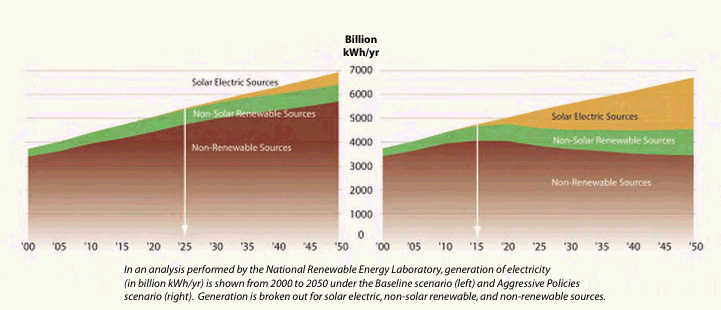
|
|
Figure 1 NREL "Analysis" of Solar and Renewable Energy Projections, piggybacked upon:
|
"Making predictions is tricky; especially about the future." -Yogi Berra
Conceptually, renewables can either absorb growth in energy demand or they can be substituted for resources going into decline. If assumptions about demand growth are excessively optimistic, then growth may be adjustable downward according to the status of renewable energy technologies available in the market. But if assumptions about non-renewable resources are excessively optimistic, then economic collapse can unravel the best laid plans for continuity of social order. In particular, if insufficient fossil fuel resources are available in society to both maintain the global economy and provide energy to manufacture and install the renewable, sustainable economy, great human suffering will become inevitable.
Therefore creating energy roadmaps is serious business and in that context it would be very irresponsible to underestimate the decline of fossil fuels. Unfortunately, information about fossil fuel reserves available from governments and industry is unreliable and/or deceptively misleading. [3] Use of such information as a foundation for renewable energy policy is dangerous.
At a recent meeting in Denver of the newly-formed ASPO-USA (Association for the Study of Peak Oil and Gas, USA), experts projected that the global peak in oil is imminent and, importantly, the decline of fossil fuels may range from 2% to 8% or even as high as 12% per year.[4] If that turns out to be the case, demand for renewable energy solutions will far outstrip the capacity of society to meet the shortfall. Pressure for nuclear, unconventional oil or low-yield, high-carbon coal could grow and environmental issues could lose priority to desperation.
In the 1990's Shell produced a much publicized graph depicting continued growth of fossil fuels until 2030 or 2040 (several scenarios were offered) and renewable energy taking hold late in the century. Others similar graphs have been produced, but because they are based on excessively optimistic views of fossil fuel reserves, they create a false sense of security in a context where white-knuckle panic would better serve us to create the possibilities for survival of civilization as we know it.
The nation of Sweden has proclaimed its goal to eliminate fossil fuels by 2020.[5] This is a step in the right direction.

|
|
Figure 1 NREL "Analysis" of Solar and Renewable Energy Projections, piggybacked upon:
|
References: